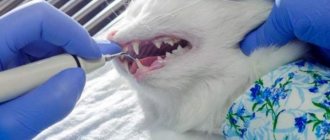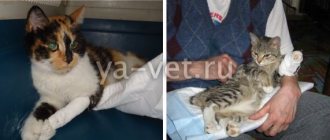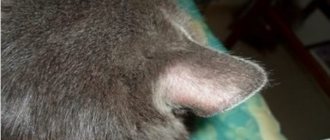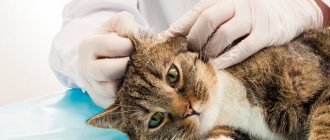7600Pavel
The cat family is distinguished by its amazing vitality and intelligence, acquired in the process of evolution and centuries of life next to humans. However, a pet's body is also susceptible to destructive effects when the cat bleeds from the mouth.
Today we will talk about this phenomenon with maximum care, consider the causes of its occurrence, treatment and preventive measures.
© shutterstock
Bleeding in the mouth
Bleeding from a cat's internal organs must be distinguished from bleeding in the mouth and throat. Usually in this case, the blood is scarlet and is not necessarily released through vomiting, but may be in the saliva.
The first thing the owner should do in this case is look into the mouth. If a bleeding wound is found in the mouth, then it will have to be treated.
Common causes of oral bleeding are all kinds of food injuries (for example, bones), eating threads and Christmas tree rain, as well as diseases of the oral cavity (gingivitis, stomatitis, tumors, etc.) and a lost tooth.
If scarlet blood is mixed with the vomit, the cause may also be a nosebleed: the animal swallows the blood and then vomits.
In any case, the blood from the nose or mouth will be fresh and scarlet.
Fundamental Concepts
If your pet is bleeding from the mouth, examine him, paying attention to:
- structure and condition of teeth and gums;
- possible damage to the lips;
- the color of the blood and its amount;
- presence/absence of odor, vomiting;
- general condition of the body: eating pattern, level of physical activity, muscle tone, thirst or dehydration.
Deviation from the norm in a cat of some indicators indicates the development of an unidentified disease. We strongly recommend that you seek qualified assistance on the same day.
Bleeding from the esophagus
Blood in vomit is most often a sign of damage to the upper parts of the digestive system - the esophagus and stomach.
A sign of bleeding from the esophagus is a scarlet color mixed with the vomit.
The reasons why a cat vomits scarlet blood can be damage from bones and rough food eaten by rain or sausage wrappers, as well as various diseases - ulcers and tumors of the esophagus.
Also, causes of bleeding in the esophagus and stomach include taking medications that corrode the mucous membrane, and coagulopathy - a blood clotting disorder, which can result in massive bleeding even with minor inflammation and slight damage to the mucous membrane.
Why is this happening
It is quite difficult to discover the causes of an unknown disease, so we will divide the further narrative into several blocks.
Injuries to the oral cavity
Drip bleeding from the mouth occurs when the surface of the head is damaged (due to “showdowns” with competitors), sensitive walls (consumption of malignant products or objects of unknown origin).
If your cat is bleeding from the mouth, pay attention to
:
- Color – shades of red or pink, depending on the degree of dilution.
- Duration - with minor injuries, blood stops flowing within ten minutes, tooth loss is accompanied by a longer period.
- The nature of the leak - liquid flowing out in jerks, indicates damage to an important vessel or large capillary of the facial area of the head.
To stop bleeding from the mouth, you will need cotton swabs treated with a manganese solution. If first aid does not bring results, contact specialized institutions.
Lung damage
If the respiratory system is affected, periodic foam from the cat's mouth mixed with pink blood is observed. The phenomenon is characterized by a small amount of fluid and no coagulation. If you notice such symptoms, immediately take your cat to a veterinary clinic.
Poisoning with toxic substances
After examining the cat's vomit, we can draw a conclusion about the nature of the ongoing disease. The presence of brown impurities indicates damage to the gastric mucosa. Often occurs due to: eating household chemicals, specialized mixtures.
If the cat has eaten rat bait, additional vitamin K injections and blood transfusions and rinsing by probing will be needed.
It is important to know! Do not induce vomiting if your cat eats toxic substances. A hasty decision can cause damage to the esophagus and respiratory organs from the moving masses.
Blood and liver damage
Problems with blood clotting indicate a destructive effect on the above-mentioned organs of the cat. Often occur during exacerbations of non-contagious diseases, and are not accompanied by the release of foam.
Bleeding in the stomach
Vomiting blood in a cat is a sign of damage to the sensitive walls of the stomach. The discharge has a brown tint and an unpleasant smell, and the consistency resembles the thick of infused tea.
The frequency of exacerbation depends on individual characteristics, degree and nature.
An exacerbation is accompanied by sharp pain in the abdominal area, which can be relieved by eating several pieces of ice and applying cold compresses to the affected area.
It is important to know!
Blood flowing out of the mouth in a stream is a clear sign of “holes” in the vessels of the abdominal cavity or stomach
. The question arises, what to do? The answer is extremely short - seek help from a veterinary clinic.
Bleeding from the stomach
A sign of bleeding from the stomach is that the blood mixed with the vomit is coagulated: it is dark red or even brown in color (like coffee) due to the content of hemoglobin digested by the stomach.
The cause of gastric bleeding in a cat can be the disintegration of a tumor, worms, poisoning, as well as mechanical damage to the mucous membrane.
Such bleeding often leads to anemia. To detect it, just look at the cat’s oral mucosa: if it turns pale, this is a clear sign. The condition is also accompanied by apathy and sometimes fever. Ultimately, it leads to death if action is not taken. You need to apply cold to the stomach and immediately go to the vet.
What leads to an increase in hematocrit
Thick blood can be caused by various pathological processes. Similar factors provoke an increase in hematocrit in men and women. But in the first case, the problem under consideration occurs more often due to the reasons described above.
Dehydration
Dehydration occurs due to:
- insufficient fluid intake into the human body;
- renal pathologies;
- course of diabetes mellitus;
- fever;
- living in a region with high ambient temperatures;
- continuous vomiting caused by severe intoxication or other pathological processes;
- persistent diarrhea resulting from food poisoning;
- chronic pyelonephritis.
We suggest you read: Can a cat infect a person with any disease?
Dehydration also threatens a person with diseases that are accompanied by an increase in body temperature. This reaction of the body is designed to normalize the patient’s condition, resulting in increased sweating and frequent urination.
A number of drugs (mostly synthetic drugs) with long-term use have a negative effect on the condition of the blood: its plasma gradually loses its liquid part, which ultimately leads to an increase in hematocrit. Such phenomena can be caused by:
- drugs used to treat pathologies of the adrenal cortex (for example, hydrocortisone);
- contraceptives taken orally;
- diuretics;
- medications intended to restore erectile function.
These tablets can be used only after agreeing on the course of treatment with your doctor and in the dosage prescribed by the specialist.
In case of gastric, intestinal and liver pathologies, some of the metabolic products are insufficiently oxidized and enter the circulatory system in this form. This leads to an increase in the content of formed elements, including glucose, while maintaining the same plasma concentration.
Impaired functioning of the respiratory system causes a decrease in the amount of oxygen entering the body. The lack of this substance provokes the onset of hypoxia and blood oxidation.
The latter circumstance negatively affects the viability of formed elements: they begin to accumulate in the vessels. As a result, against the background of hypoxia, the process of breakdown of blood cells and the release of products that worsen the course of the pathological condition are accelerated.
An increase in the amount of cholesterol in the blood is known as hypercholesterolemia. This process helps to increase the hematocrit. In this case, a change in blood viscosity occurs against the background of the active entry into the plasma of not only cholesterol, but also other elements: triglycerides, lipoproteins.
Infection of the body
Infection of the body with various infections or parasitic life forms leads to activation of the immune system. Its cells penetrate into the circulatory system, where they subsequently die, thereby increasing the plasma concentration.
This process is due to the fact that some leukocytes are constantly located in the submucosal layer of the intestine. This organization allows you to avoid the state of overcrowding of blood vessels. However, in case of helminthic or infectious pathology, leukocytes return to the bloodstream, as a result of which the viscosity of the liquid increases.
Strong experiences lead to an increase in the level of various components in the bloodstream: cholesterol, glucose and other elements. At the same time, to increase hematocrit, it is necessary that a person regularly experiences nervous strain. Episodic stress has little effect on the state of the circulatory system.
At the same time, the regular release of adrenaline into the blood, which occurs against the background of nervous experiences, not only increases the hematocrit, but also negatively affects the functions of the bone marrow.
Other factors
There are quite a few factors that provoke the appearance of thick blood. These also include:
- negative environmental influences, smoking, exposure to carbon dioxide and exhaust gases;
- antiphospholipid syndrome;
- erythremia, in which the level of red blood cells increases;
- leukemia;
- myeloma;
- cirrhosis of the liver;
- hepatitis;
- pancreatitis;
- phlebeurysm;
- thermal burns.
Poor nutrition is another fairly common cause of blood thickening. The appearance of this consequence is explained by the fact that after products have entered the body, the immune system releases many cells to cleanse them of foreign elements. That is, after each meal a person’s blood becomes a little thicker.
In a newborn, blood parameters differ significantly from those in adults and children over the age of one year. They normalize over time. In particular, newborns have high levels of hemoglobin and red blood cells.
These phenomena are due to the fact that the child’s body finds itself in an unfamiliar environment and reacts accordingly. By about a year, all indicators are restored and approach those of adults.
Cat vomits pink foam
If a cat vomits foam mixed with blood, the end result is pink. There is no need to be afraid of the foam itself, because... it could just be stomach acid. However, foam may also indicate the presence of serious diseases of the internal organs. Therefore, it is better to show the cat to a veterinarian.
If the cat not only vomits, but also coughs pink foam, this may be caused by a respiratory infection, and as a result, the cough irritates the vomiting center and vomiting occurs. Blood impurities in it appear as a result of rupture of small capillaries.
Hidden bleeding
If bleeding begins in organs that do not communicate with the external environment, or is not accompanied by vomiting, the owner may not notice it. In this case, the only signs will be general symptoms:
- apathy and drowsiness;
- increased body temperature;
- dyspnea;
- weakness;
- pallor of the mucous membranes of the mouth;
- abdominal enlargement.
If such symptoms occur, you need to take the cat to the veterinarian. And it’s even more worthwhile to hurry if such symptoms began soon after bloody vomiting. This means that the bleeding is quite severe and the mucous membrane does not heal.
Damage to mucous membranes
In various diseases, the mechanism of symptom development is clear in most cases. But why does a healthy person bleed from the mouth? In most cases, this is due to damage to the surface of the mucous membrane. Minor capillary bleeding occurs when biting the inner surface of the cheeks, tongue, or lips. The symptom often develops after dental procedures. In most cases, blood appears from the child’s mouth in this way. Children often bite their lips and cheeks after anesthesia, as the tissues lose sensitivity.
With severe inflammation of the tonsils, blood is often detected when rinsing the throat. Also, red streaks in the sputum are sometimes observed in patients with pharyngitis. This symptom indicates minor damage to the vessels of the pharynx. Such pathologies are not accompanied by dangerous bleeding. However, it is recommended to get checked. Blood from the throat may indicate oral cancer. Damage to the gums can also be dangerous. In some cases, it indicates the development of diseases such as thrombocytopenic purpura, hemophilia or scurvy.
First aid
If you notice that your cat has vomited blood or is experiencing bad symptoms, you need to take the following measures: stop giving food for at least 12 hours and ensure rest. Food will only aggravate the damage to the mucous membrane at a time when it could be spending energy on regeneration. Ideally, you should not feed the animal all day long, i.e. 24 hours. But, if you see that the animal is no longer vomiting, bleeding does not appear in any way, the cat behaves as if healthy, it has an appetite, it runs and plays, then after 12-24 hours it can be given gentle food. It is better for a cat to come out of fasting with the help of mucous infusions of rice, vegetable puree in broth, boiled chicken or turkey meat.
To soothe and heal the mucous membranes, you can give your cat a warm decoction of chamomile. The cat itself most likely will not want to drink it, so it needs to be injected into the mouth in small portions from a syringe without a needle. You cannot inject in large portions, because... this may trigger further vomiting.
If, in addition to bloody vomiting, you see the life-threatening symptoms described above, or the vomiting recurs, then you need to go to the veterinary clinic.
Veterinarian help
At the clinic, the veterinarian can perform blood tests, x-rays, ultrasound and endoscopy. A biochemical blood test, virus tests, and fecal tests may also be prescribed. The list of studies will depend on what symptoms, in addition to vomiting, are observed in the cat. If they resemble an infectious disease, there will be some tests, if a foreign object is suspected, then others, etc.
Treatment is determined after diagnosis. But there are cases when the doctor cannot even determine the presence of foreign objects, because X-rays do not show them. As a result, cats remain without a diagnosis for several days. Case from practice. The cat ate the ribbon, after which she began vomiting blood, dehydration and pancreatitis. As a result, veterinarians suspected several diagnoses at once, because... The x-ray showed nothing. At this time, they admitted her to the clinic and maintained the cat’s condition with IVs and other means. As a result, the ribbon came out naturally. The fact that the veterinarians were unable to make a diagnosis is certainly bad. But, on the other hand, they helped maintain the cat’s stable condition while the body dealt with the problem on its own. Otherwise, she could have died from blood loss or dehydration before the ribbon came out.
More often than not, a diagnosis can be made. In the case of a foreign object entering the stomach, the risk of surgery or attempts to remove it naturally is assessed. It all depends on what kind of item it is.
There are cases when even swallowed sewing needles with the help of Vaseline came out through the intestines without damaging it. However, most often in such cases, surgery is prescribed, because if the object does pierce the intestines, the consequence will be quick death.
If the problem is caused by minor damage to the gastrointestinal tract due to unsuccessful food, in particular bones, then treatment is usually conservative: diet (first hungry, then gentle) and monitoring the pet’s condition.
To speed up the healing of the mucous membrane of the stomach and intestines, a cat can be given a dietary supplement with the amino acid glutamine 500 mg twice a day. It is easy to grind into powder and mix with food. Of course, this must be done after the cat has been on a fasting diet for the prescribed time. The amino acid is sold in regular human pharmacies.
Until the cat stops bleeding, its condition must be maintained so that it does not die from dehydration or blood loss. For this purpose, IVs and injections are given.
In a situation where bleeding is caused by serious diseases, they begin to treat not only their consequences (that is, bleeding), but also the root cause. In any case, only a veterinarian can prescribe treatment.
Loving owners always worry about their pets. And seeing how blood appears in the cat’s urine or feces, a conscientious owner will rush with the animal to the veterinarian, rather than hope that it will go away on its own. Normally this shouldn't happen. And if you notice such changes in your animal, then you should not guess and look for the reason yourself. Without special education and work experience, you can make a mistake when making a diagnosis, thereby ruining your cat. Incorrect treatment will not only lead to the disease worsening in its course, but also to the fact that internal organs may cease to function properly.
Drug therapy
Treatment of thick blood involves taking measures aimed at both thinning it and suppressing the cause. To achieve these goals, the following are appointed:
- procedures to restore metabolism;
- drugs that prevent the formation of blood clots;
- measures to eliminate tumor formations.
The following drugs play an active role in eliminating the problem under consideration:
- Aspirin, Cardiomagnyl, Dipyridamole and Tirofiban. They help thin the blood and normalize blood flow. These drugs are not prescribed for the following pathologies:
- ulcers of the stomach and duodenum;
- bronchial asthma;
- liver dysfunction;
- hypertension;
- presence of allergies to drug components;
- pregnancy.
- If these pathologies are detected, these drugs are replaced with others: Neodicoumarin, Warfarin, Heparin.
Therapy of the pathological process also includes measures and drugs designed to eliminate the underlying disease. Therefore, the treatment regimen is determined depending on the patient’s individual indicators.
Blood in stool
Sometimes this phenomenon is not something terrible. For example, if there was little blood, and this case was registered by you only once, then most likely the reason is that during defecation, hard feces scratched the mucous membrane of the rectum and damaged the anal sphincter. Be sure to add more wet food and increase the amount of water in the diet. Review your diet to prevent your pet from becoming constipated. Otherwise, it will turn into a chronic sore with serious complications.
If there is a large amount of blood in the cat’s stool or this happens very often, then it is necessary to contact a veterinary clinic for a more thorough examination and a correct diagnosis. Sometimes the reasons lie in the fact that the cat has developed a bacterial disease or helminthiasis (in this case, the cat most often has diarrhea with blood, especially if the disease is viral in nature). Sometimes allergies manifest themselves this way. Do not forget that polyps in the intestines can lead to bloody stool.
Older pets sometimes develop intestinal cancer. And it causes the cat to stool with blood. But in addition to problems with the intestines themselves, do not forget about the blood. If a pet has been poisoned by zoocoumarin (or another rodent poisoning substance) or blood thinners, its clotting ability is impaired. As a result, bleeding can be recorded not only in the stool. Any injury is life-threatening. And each cause requires its own treatment.
Bowel cancer in a cat
2. Not sterilized
4. Not dewormed
5. Frisas dry food, sometimes vegetables
09/25/12 I began to eat little, my stools are loose and brown. The nose is dry.
09.26.12 Depressed state, almost complete refusal of food (I ate just a little chicken broth), often walks around in small groups.
09/28/12 I felt more cheerful in the morning, BUT! Found feces with blood (stool ratio = 5050).
We took him to the veterinary clinic. The doctor said that the cat was pale and had anemia (but with us she was always pale and weighed little). She suggested doing an ultrasound. She didn’t suggest doing any more tests! She even refused a stool test.
Based on the results of the ultrasound, I concluded that the cat had intestinal cancer. She said the cat would not live long and suggested putting it to sleep. We categorically refused. Then she prescribed us “life-sustaining” medications: Enrosept, Veracol, Travmatin and Thiosulfate. On the third day we give an IV (sodium chloride and glucose solution).
Among the improvements as of 09/30/12: The cat has gained a little weight, she eats just a little bit at a time. But there is still a lot of blood in the stool!
Today we will go to another veterinary clinic. We will require a blood test (biochemical and clinical).
Because there is no treatment, but I really want to save the cat!
Tell me, what else can be done? Maybe an x-ray? Histology? Colonoscopy?
Structure: homogeneous fine-grained
Intrahepatic veins: not dilated
Portal vein: not dilated
Vascular pattern: lunch
Dimensions: not enlarged
Wall: not thickened
Bile duct: not dilated
hypoechoic diffusely changed
Edge: uneven pointed
Splenic veins: not dilated
Dimensions: not enlarged Right 3.8 2.4 Left 3.7 2.5
Echogenicity of the cortical layer: increased
Cortico-medullary differentiation: preserved
Pelvis: not dilated, thickened
Contents: anechoic homogeneous
The size of the uterine horns: not enlarged.
I don’t want to believe in this terrible diagnosis.
Write what you prescribed? If severe anemia requires hemobalance at first, ferrum lek folic. hemostatic drugs. What color is blood?
Couldn’t she have eaten something that could have damaged the intestines?
Change the food. Special food is needed to treat the gastrointestinal tract. Hills, Royal Canin, Purina
The previous doctor prescribed Enrosept, Veracol, Travmatin and also Glucose with Sodium thiosulfate.
The cat's condition has improved. He has an appetite, eats little by little, but often, and the depressed state has almost gone away. Today I passed a lot, the stool was red, semi-liquid, but without blood.
She could eat anything we wanted. She is always very curious, sometimes crawls under the bathtub, licks concrete walls, and could of course look into the trash and eat bones. This is possible with our cat.
Now we feed the children gruel, he eats with pleasure, but dry food is useless.
Khvostov: at home - 1, in the family - 3 (from 3 to 8 years old)
City of Korolev, Moscow region.
Better baby food, puree, except pork and fish, without spices and potatoes
The cat has become more active. But he worries that he doesn’t drink water at all. He only eats baby food. Little trips to the toilet have become strange: he turns around on the tray, sits down and immediately gets up. And so several times in a row. It’s obvious that she wants to, but she doesn’t seem to be able to do it.
It’s just strange to me that, according to the doctor, the medicine didn’t work, because... the blood is thick, did it get into the vein at all, this is the first time I’ve heard that IV infusions don’t work because of the thickness of the blood, so take it for analysis when it’s thick, yes, it’s a little difficult to strain, but what didn’t flow IV is strange .
It would also not hurt to take a series of x-rays with barium.
You can also post the ultrasound on the zoovet website by creating a thread in the appropriate thread.
He doesn’t drink water because he is on a natural diet; cats often don’t drink in nature.
Be sure to have your urine and stool analyzed.
To our question about handing over the kalamochi, he replied: “Well, you can do it, but I don’t think we’ll find anything there.” And all this was said in some casually pathetic form. In general, he assured us that “you rejoice early, the improvement came from the medications. Do a laparotomy, and then if it works out, we’ll do the operation; if not, euthanasia).”
Tomorrow we will try to donate stool and urine. But in another clinic.
The fact of the matter is that she didn’t put the catheter in a vein, but put her paw (probably didn’t get it), when the catheter is in the vein normally, all the medicine goes through the vein, and so it turns out under the skin, the current is in the paw under the skin There isn't as much room as at the withers, that's why she puffs up like a bubble.
When the blood is thick, it is very difficult to draw it, you don’t need to be a doctor to understand this, it does not flow, drops barely flow into the test tube.
What kind of doctor is this, everything about euthanasia, and about it (((
He needs to treat the cat, and not persuade the owners to euthanize!!!
In the conclusion of the ultrasound, the diagnosis is not confirmed, but presumptive.
2. Not sterilized
4. Not dewormed
Wall: not thickened
Blood in urine
Blood in the urine is not a good sign. This should alert you. The causes may lie in inflammatory processes in the kidneys or bladder and ureters. It is very painful for the animal to relieve itself. In addition, it is very dangerous for his life. The infection can spread throughout the body as blood is forced through the kidneys. And if they are colonized by bacteria or viruses, then each “batch” of blood filtered by the kidneys will be infected. And so the infection will spread throughout the body.
Blood appears in the urine as a result of poisoning, injuries to internal organs, or even due to certain helminths. But sometimes it’s worth paying attention to the instructions on the medications that were given to your pet. Some people have these side effects. A cat blood test can help you learn more about your pet's condition. This is a real hint card for the doctor. Using a blood test, you can find out whether the cat is sick and who the culprit is: bacteria, virus or helminth.
Treatment
If your cat has thick blood, the optimal treatment should be prescribed by the attending veterinarian, taking into account the underlying cause of the condition. Treatment methods and an adequate treatment regimen are selected based on the underlying disease that caused the homeopoiesis disorder.
Animals with abnormal blood parameters are prescribed symptomatic therapy aimed at relieving clinical symptoms and normalizing their general condition. Without fail, the veterinarian will prescribe the patient anticoagulants - medications that thin the blood. Prevents the formation of blood clots.
Important! Owners of animals who have been diagnosed with chronic pathologies that cause blood thickening need to take their pets to the veterinary clinic several times a year for tests. Serological studies will allow you to determine the state of the blood, the presence of systemic diseases, and diagnose pathologies in a timely manner.
Cats are prescribed cardiomagnyl, magnecard, and aspercard in recommended dosages. To thin the blood of animals, heparin and fragmin are used in therapeutic therapy. In case of increased blood clotting, fibrinolytic therapy is performed. For liver pathologies, animals are prescribed hepatoprotectors and restorative medications.
After treatment, cat owners must adhere to all recommendations of the treating veterinarian, observe the frequency of medication doses, and adhere to the established treatment regimen.
After completing treatment therapy, even if the pet’s condition has returned to normal, we recommend that you take the animal again for diagnostics . Make sure your cat always has access to fresh, clean water. If your pet is kept on a natural diet, supplement the diet with multivitamin supplements and mineral complexes.
If you notice the first symptoms of any disease, be sure to contact your veterinarian. Any pathology or disease can be cured in the early stages.











